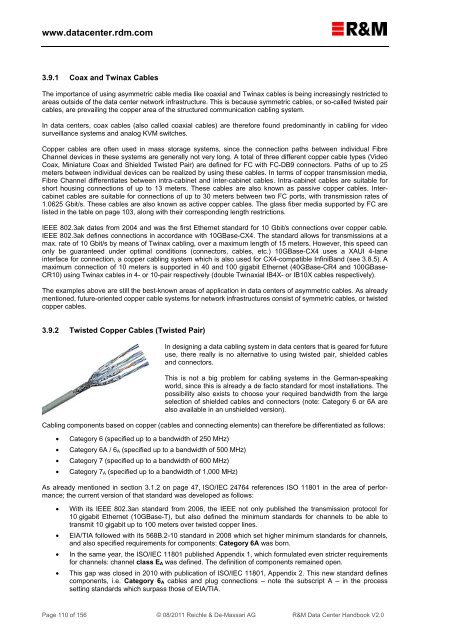R&M Data Center Handbook
R&M Data Center Handbook
R&M Data Center Handbook
Create successful ePaper yourself
Turn your PDF publications into a flip-book with our unique Google optimized e-Paper software.
www.datacenter.rdm.com<br />
3.9.1 Coax and Twinax Cables<br />
The importance of using asymmetric cable media like coaxial and Twinax cables is being increasingly restricted to<br />
areas outside of the data center network infrastructure. This is because symmetric cables, or so-called twisted pair<br />
cables, are prevailing the copper area of the structured communication cabling system.<br />
In data centers, coax cables (also called coaxial cables) are therefore found predominantly in cabling for video<br />
surveillance systems and analog KVM switches.<br />
Copper cables are often used in mass storage systems, since the connection paths between individual Fibre<br />
Channel devices in these systems are generally not very long. A total of three different copper cable types (Video<br />
Coax, Miniature Coax and Shielded Twisted Pair) are defined for FC with FC-DB9 connectors. Paths of up to 25<br />
meters between individual devices can be realized by using these cables. In terms of copper transmission media,<br />
Fibre Channel differentiates between intra-cabinet and inter-cabinet cables. Intra-cabinet cables are suitable for<br />
short housing connections of up to 13 meters. These cables are also known as passive copper cables. Intercabinet<br />
cables are suitable for connections of up to 30 meters between two FC ports, with transmission rates of<br />
1.0625 Gbit/s. These cables are also known as active copper cables. The glass fiber media supported by FC are<br />
listed in the table on page 103, along with their corresponding length restrictions.<br />
IEEE 802.3ak dates from 2004 and was the first Ethernet standard for 10 Gbit/s connections over copper cable.<br />
IEEE 802.3ak defines connections in accordance with 10GBase-CX4. The standard allows for transmissions at a<br />
max. rate of 10 Gbit/s by means of Twinax cabling, over a maximum length of 15 meters. However, this speed can<br />
only be guaranteed under optimal conditions (connectors, cables, etc.) 10GBase-CX4 uses a XAUI 4-lane<br />
interface for connection, a copper cabling system which is also used for CX4-compatible InfiniBand (see 3.8.5). A<br />
maximum connection of 10 meters is supported in 40 and 100 gigabit Ethernet (40GBase-CR4 and 100GBase-<br />
CR10) using Twinax cables in 4- or 10-pair respectively (double Twinaxial IB4X- or IB10X cables respectively).<br />
The examples above are still the best-known areas of application in data centers of asymmetric cables. As already<br />
mentioned, future-oriented copper cable systems for network infrastructures consist of symmetric cables, or twisted<br />
copper cables.<br />
3.9.2 Twisted Copper Cables (Twisted Pair)<br />
In designing a data cabling system in data centers that is geared for future<br />
use, there really is no alternative to using twisted pair, shielded cables<br />
and connectors.<br />
This is not a big problem for cabling systems in the German-speaking<br />
world, since this is already a de facto standard for most installations. The<br />
possibility also exists to choose your required bandwidth from the large<br />
selection of shielded cables and connectors (note: Category 6 or 6A are<br />
also available in an unshielded version).<br />
Cabling components based on copper (cables and connecting elements) can therefore be differentiated as follows:<br />
• Category 6 (specified up to a bandwidth of 250 MHz)<br />
• Category 6A / 6 A (specified up to a bandwidth of 500 MHz)<br />
• Category 7 (specified up to a bandwidth of 600 MHz)<br />
• Category 7 A (specified up to a bandwidth of 1,000 MHz)<br />
As already mentioned in section 3.1.2 on page 47, ISO/IEC 24764 references ISO 11801 in the area of performance;<br />
the current version of that standard was developed as follows:<br />
• With its IEEE 802.3an standard from 2006, the IEEE not only published the transmission protocol for<br />
10 gigabit Ethernet (10GBase-T), but also defined the minimum standards for channels to be able to<br />
transmit 10 gigabit up to 100 meters over twisted copper lines.<br />
• EIA/TIA followed with its 568B.2-10 standard in 2008 which set higher minimum standards for channels,<br />
and also specified requirements for components: Category 6A was born.<br />
• In the same year, the ISO/IEC 11801 published Appendix 1, which formulated even stricter requirements<br />
for channels: channel class E A was defined. The definition of components remained open.<br />
• This gap was closed in 2010 with publication of ISO/IEC 11801, Appendix 2. This new standard defines<br />
components, i.e. Category 6 A cables and plug connections – note the subscript A – in the process<br />
setting standards which surpass those of EIA/TIA.<br />
Page 110 of 156 © 08/2011 Reichle & De-Massari AG R&M <strong>Data</strong> <strong>Center</strong> <strong>Handbook</strong> V2.0


